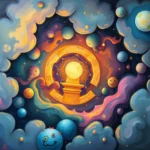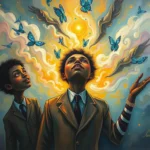
Introduction
Dreaming is a fascinating realm where the conscious mind takes a backseat, allowing the subconscious to manifest itself in a tapestry of symbols, scenarios, and emotions. This dream state serves not only as a nightly escape but also as a medium through which our inner thoughts and feelings communicate. It is no wonder that dream interpretation has captivated people throughout history, from ancient civilizations to modern psychological practices.
The allure of dreams lies in their complexity and the profound insights they can provide into our waking lives. When we explore the symbols and themes that appear in our dreams, we embark on an inner journey that can reveal hidden truths about ourselves, our desires, and our fears. In this article, we will delve into the symbolism and meaning behind common dreams, examine various scenarios that can alter their interpretations, and uncover the real-life connections that can be drawn from these nocturnal narratives.
Symbolism and Meaning
Dreams often use symbols to convey messages from the subconscious. Each symbol can have multiple meanings, often influenced by personal experiences, cultural backgrounds, and emotional states. One of the most common symbols found in dreams is water. Water can embody a variety of feelings, representing the depths of our emotions, the flow of life, or even the unconscious mind. For instance, calm waters may signify peace and tranquility, while turbulent waters could indicate emotional turmoil or stress.
Another prevalent symbol is flying, which can suggest a sense of freedom, aspiration, or transcendence. The experience of soaring above the ground may reflect a desire to rise above challenges, escape from daily pressures, or achieve personal goals. However, if flying is accompanied by fear or an inability to control the flight, it may point to feelings of insecurity or a lack of control in one’s life.
Chasing is yet another common dream motif. When someone is being chased in a dream, it often represents avoidance or fear—whether it is of a situation, emotion, or even a person. The chaser symbolizes that which the dreamer is trying to escape, illuminating the aspects of life that may need confronting. The nature of the chaser can also influence the dream’s meaning; a familiar face may indicate unresolved issues with that person, while an unknown figure could symbolize a fear of the unknown.
In addition to these symbols, animals frequently appear in dreams and can evoke a wide array of interpretations. A lion may represent courage and strength, while a snake might signify transformation, healing, or even betrayal. The specific qualities of the animal in the dream, coupled with the dreamer’s emotional response to it, can provide crucial insights into the dream’s message.
Understanding these symbols involves more than just identifying them; it requires personal reflection. Each individual’s unique experiences shape the meanings of these symbols in their dreams. Therefore, recognizing what each symbol evokes within oneself is essential for a deeper understanding of one’s inner journey.
Key Scenarios and Variations
The interpretation of dreams can significantly vary based on the context and scenarios presented. For instance, dreaming of being lost can evoke different feelings and insights depending on the specifics of the dream. If the dreamer finds themselves lost in a familiar place, it may indicate feelings of confusion or disorientation in their waking life, perhaps due to a recent life change. Conversely, being lost in an unfamiliar environment might symbolize a sense of adventure or the unknown, suggesting a willingness—or reluctance—to step outside of one’s comfort zone.
Another common scenario is falling, which can evoke intense emotions. Falling dreams can often reflect feelings of insecurity or loss of control. However, if the dreamer experiences a sense of freedom or exhilaration while falling, it could symbolize a release of fears or a leap of faith into something new.
Dreams about death also carry profound meanings and can vary widely based on the situation. While many may view death in dreams as ominous, it often symbolizes transformation or change, signaling the end of one phase of life and the beginning of another. For example, dreaming of a deceased loved one may provide comfort and closure or may highlight unresolved feelings related to that person.
Another intriguing variation is the recurring dream, where a particular scenario repeats itself over time. Recurring dreams often point to unresolved issues or emotions that the dreamer has yet to confront. Exploring the elements of these dreams can reveal patterns in one’s behavior, relationships, or emotional health that necessitate attention.
The environment in which these dreams occur can also shift their meaning. For instance, a dream set in a school may evoke feelings of learning and growing, while a dream in a workplace may signify responsibilities and ambitions. Additionally, the emotional tone of the dream—whether it is filled with joy, fear, or confusion—can greatly influence its interpretation.
Real-Life Connections and Takeaways
Connecting dreams to real-life situations can provide profound insights and opportunities for self-reflection. Dreams serve as a mirror to our waking life, revealing our innermost thoughts and feelings. By paying attention to the symbols and scenarios in our dreams, we can gain clarity on our current emotional state and life circumstances.
To begin this process of reflection, consider maintaining a dream journal. Recording your dreams upon waking can help you capture the details while they are fresh, allowing you to analyze patterns and recurring motifs over time. As you write, reflect on the emotions you felt during the dream and how they relate to your waking life.
Moreover, take time to explore how the symbols and scenarios align with your personal experiences. For example, if you frequently dream of being chased, consider what aspects of your life you may be avoiding. Are there situations or emotions you need to confront? Understanding these connections can empower you to address underlying issues, leading to personal growth and healing.
Engaging in mindfulness practices can also enhance your ability to interpret dreams. Techniques such as meditation and guided imagery can help you connect with your subconscious and tap into your intuition. As you cultivate a deeper awareness of your thoughts and feelings, you may find it easier to decode the messages within your dreams.
Furthermore, consulting with a professional dream analyst or therapist can provide valuable insights. Trained professionals can help you unpack the layers of your dreams, offering new perspectives and interpretations that may not be immediately apparent. This collaborative exploration can illuminate areas in your life that require attention and foster a deeper understanding of your personal journey.
Ultimately, dreams are a gateway to self-discovery and introspection. They provide a unique opportunity to explore the hidden facets of our psyche and illuminate the paths we may need to take in our waking lives. As you engage with your dreams, allow yourself to be curious and open-minded. Embrace the process of exploration, and let your dreams guide you on your inner journey.
Conclusion
The exploration of dreams and their symbols offers a gateway to understanding our inner selves. By recognizing the significance of common dream symbols and the variations in their scenarios, we can gain deeper insights into our waking lives. As we connect the dots between our dreams and real-life experiences, we unlock the potential for personal growth, healing, and transformation.
Encourage yourself to reflect on your own dreams, keeping in mind that their meanings are deeply personal and can evolve over time. Through this exploration, you can embark on a profound inner journey that reveals not just the secrets of your subconscious but also the essence of who you truly are. Remember, each dream is an invitation to delve deeper into the mysteries of your mind, offering a chance to confront fears, embrace change, and ultimately, discover your path.







